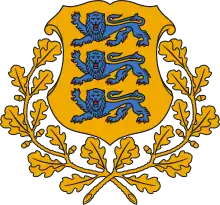Kaarel Eenpalu [Note 1] | |
|---|---|
 | |
| 13th State Elder of Estonia | |
| In office 19 July 1932 – 1 November 1932 | |
| Preceded by | Jaan Teemant |
| Succeeded by | Konstantin Päts |
| Acting Prime Minister of Estonia | |
| In office 24 April 1938 – 9 May 1938 | |
| President | Konstantin Päts |
| Preceded by | Konstantin Päts As President-Regent |
| Succeeded by | himself as Prime Minister |
| 7th Prime Minister of Estonia | |
| In office 9 May 1938 – 12 October 1939 | |
| President | Konstantin Päts |
| Preceded by | himself as Acting Prime Minister |
| Succeeded by | Jüri Uluots |
| Personal details | |
| Born | 28 May 1888 Vesneri Parish (now Tartu Parish), Kreis Dorpat, Livonia, Russian Empire |
| Died | 27 January 1942 (aged 53) Kirov Oblast, Soviet Union |
| Political party | Estonian People's Party |
Kaarel Eenpalu (until 1935 Karl August Einbund) (28 May [O.S. 16 May] 1888,[1] – 27 January 1942) was an Estonian journalist, politician and head of state, who served as 7th Prime Minister of Estonia.
Education
Eenpalu was educated at the Hugo Treffner Gymnasium in Tartu. Between 1909 and 1914 he studied law at Tartu University and later graduated from Moscow University.
Journalism
From 1910 to 1912 and in 1915 he was member of the editorial board of the Postimees ("The Postman") daily in Tartu, in 1918 editor of Postimees, in 1920 editor-in-chief of Tallinna Teataja ("The Tallinn Gazette") daily, and in 1924 editor-in-chief of the Kaja ("Echo") newspaper.
War
._Vene_t%C3%A4nav%252C_Tartu%252C_1919.%252C_TM_F_1445-1.jpg.webp)
Eenpalu was active in World War I, serving as a battery commander in the First Estonian Artillery Regiment in 1917 and 1918. During the Estonian War of Independence in 1918–1919, he first commanded the Tartu High School students' battalion, and then a battery in the Second Estonian Artillery Regiment.
Political career
Eenpalu was a member of the Estonian Constituent Assembly (Asutav Kogu, 1919–1920), member of the unicameral parliament (Riigikogu, 1920–1937), member of the lower house (Riigivolikogu) of the bicameral parliament since 1938), and held a series of high government offices in the independent Republic of Estonia in 1918–1940. In 1919–1920 he was State Controller. In 1920, 1921–1924, and 1924–1926 he held the position of the Minister of Internal Affairs, and can thus be considered a founder of the Estonian Police. From 22 June 1926 to 19 July 1932 and from 18 May 1933 to 29 August 1934 he was Speaker of the III, IV and V Riigikogu.[2] From 19 July to 1 November 1932 he was the head of state (Riigivanem, literally "Elder of State"). In 1934–1938 he was again Minister of Internal Affairs, and in 1938–1939 he was the Prime Minister of Estonia.
Capture
After the Soviet Union occupied Estonia on 17 June 1940, Eenpalu, along with a number of other leading Estonian politicians, was arrested in July 1940 and subsequently deported to Russia. He died in 1942 in a Soviet prison camp in Vyatka (Vyatlag), Kirov (Vyatka) Oblast.
Awards
- 1927 – Order of the Estonian Red Cross I/II
- 1930 – Order of the Cross of the Eagle I
- 1935 – Order of the Estonian Red Cross I/I
- 1938 – Order of the White Star I
- 1939 – Order of the National Coat of Arms I
Personal
Kaarel Eenpalu was married to women's activist Linda Eenpalu. They had three daughters: Helmi-Aino (1917), Virve (1919), Tiiu-Hilja (1921) and Mai-Linda (1923). Politician Anne Eenpalu (born 1954) is Kaarel Eenpalu's granddaughter.
Notes
- ↑ Kaarel Eenpalu was named Karl August Einbund until 1935, when he Estonianized his name.
References
- ↑ "Karl August Einbundi sünd" (in Estonian). Histrodamus. Retrieved 8 June 2013.
- ↑ "Riigikogu juhatus". Riigikogu.
External links
 Media related to Kaarel Eenpalu at Wikimedia Commons
Media related to Kaarel Eenpalu at Wikimedia Commons
